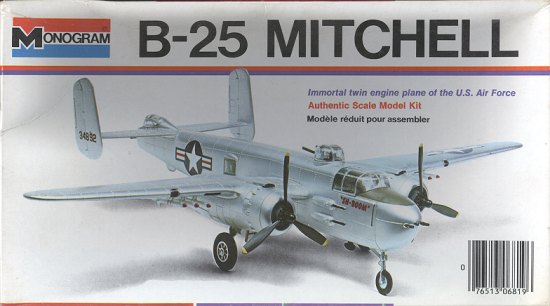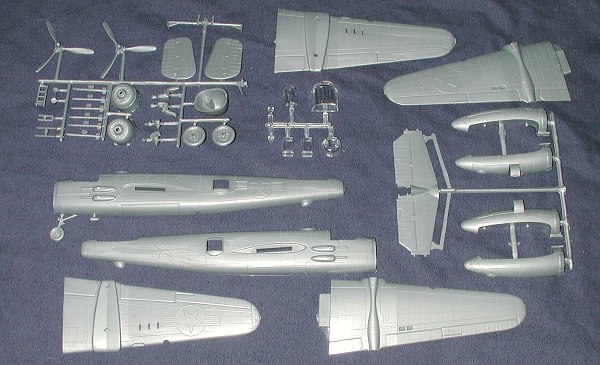
|
KIT: |
Monogram 1/69.5 B-25 H Mitchell |
|
KIT # |
6819 |
|
PRICE: |
$ Long out of production |
|
DECALS: |
One aircraft |
|
REVIEWER: |
|
|
NOTES: |
Boxing dates are 1955 and 1973 |

|
HISTORY |
In order to accommodate a seated gunner, the aft fuselage was deepened slightly and the tail was raised seven inches further above the fuselage reference line than it was on previous Mitchell versions. A transparent cupola was provided for the tail gunner, who sat behind a wall of armor plate that protected him from gunfire from the rear. In addition, the upper turret was moved forward on the fuselage to a position above the navigator's station in order to maintain proper balance against the additional weight added to the rear by the waist guns and tail turret. This new turret was more heavily braced and had a higher dome than did previous Mitchell dorsal turrets.
One of the more controversial changes introduced by the B-25H was the deletion of the co-pilot position. The elimination of the co-pilot's seat, armor plate, and controls resulted in a saving of over 300 pounds of weight. At the position of the copilot, a jump seat for the navigator was provided since his position had now been preempted by the forward-moved dorsal turret. General James Doolittle had always questioned the need for a copilot in the B-25 and B-26. However, General George Kenney, commander of the Fifth Air Force in the Pacific, vehemently objected and claimed that he needed the second pilot for long, over-water missions under hazardous conditions. However, General Arnold overruled these objections, and the B-25H was delivered without a co-pilot's position.
|
THE KIT |

My good buddy Roger Jackson tells me that this is the first fully injected plastic aircraft kit that Monogram did and judging by the 1955 initial release date and other aspects of the kit, I believe him! He also tells me that it scales out to 1/69.5 which is close enough to 1/72 to make most people happy. Monogram chose the B-25H version to kit and in that respect, they hit all the salient features of the type when they did the model. As you might expect, it is chock full of rivets (which makes it very 'accurate' by the days standards).
Other than control surfaces and doors, the detail is raised. Considering the technology of the time, it is relatively free of ejector pin marks, though each of the 'pylons' for the rockets has a doozie on it. Only a couple of small sink marks were found opposite alignment pins and there is no flash at all. To help us out, the spot where the insignia are to be placed is prominently molded on the wings and fuselage. Interestingly, there are no similar 'guides' for the serial and aircraft name.
While the model could be made right from the box and represent a B-25H fairly well, there are some things that could be changed. For instance, the wheels are too skinny and very toy-like, The engines and their ejector exhaust stubs will also have to go as they are only poor representations of the actual items. That really is about it. Yeah, there is no interior and the main gear are not that well done either, but really, it isn't that bad. From what I can see, this is not the same kit as the current 'Snap tite' B-25 that is on the market.
Markings are nostalgia to the max for your editor. Lots of nice drawings
showing the various construction and decaling steps. All the parts are
labeled and there is a written explanation of each step. Naturally, one
needs the heated knife to attach the main wheels so they will roll. It was
most kind of Monogram to mold this kit in "...aluminum colored plastic with glistening metallic finish and fine detail." so we don't have to paint it.
glistening metallic finish and fine detail." so we don't have to paint it.
Frankly, I suspect the markings of being totally spurious. I seriously doubt if any B-25H was armed with rocket rails and I'm equally sure that they were being cut up well before 1947 when the red bar was added to the national insignia. Fortunately, there are 1/72 sheets for the H model and one of them should fit this kit without too much problem. Or you could go ahead and use what's in the kit just to have something to remind you of your youth. Why not.
|
CONCLUSIONS |
Most modelers will avoid a kit like this like the plague. It is really not in the same league as the best 1/72 B-25 series (so far) that is available from Italeri. Yes, the Italeri kits are raised panel lines as well, but they are very nicely done and make into super models. We old-timers will have this kit in our collections to remind us of what it was like to be very young.
If you would like your product reviewed fairly and quickly by a site that has over 200,000 visitors a month, please contact me or see other details in the Note to Contributors.